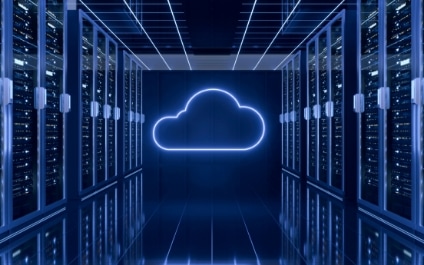
While the cloud is quickly becoming the norm for companies’ IT infrastructures, on-premises networks still have their place in the modern business landscape. As revolutionary as the cloud is for SMBs, it has its own set of pros and cons, and you might find that a traditional in-house IT network is the best option for your needs.
This article examines and compares both on-premises and cloud networks so you can make an informed decision about which infrastructure model is right for your business.
What is on-premises IT infrastructure?
On-premises infrastructure refers to the old way of doing things: servers, storage, and networking hardware physically located within your place of business. Your team manages everything, from software updates to hardware maintenance.
The on-premises model model gives you full control over your systems, which is great if compliance or data sovereignty is a concern. However, it also means you have more responsibility and higher costs, as you have to pay for not just the equipment, but maintenance and payroll for extra IT employees as well.
What is cloud infrastructure?
With a cloud infrastructure, your IT resources are hosted and managed off site by a provider. The more popular public options you may have heard of include Amazon Web Services (AWS), Microsoft 365, or Google Cloud. You access applications, storage, and servers over the internet, as the hardware is located far away in a data center run by your provider.
Cloud solutions are scalable, flexible, and typically billed on a pay-as-you-go basis, so you can stay lean and agile without investing heavily in hardware. To get these benefits, though, you must hand over a certain level of control to your provider.
Comparing on-premises vs. cloud IT infrastructures
Now, let’s take a look at how these models compare and how they can meet your needs.
Cost comparison
Initial costs differ significantly between these two models. On-premises systems require investment in hardware, licenses, cooling, and physical space. You’ll also need new or outsourced staff for maintenance and upgrades.
Cloud models shift the expense to a subscription or usage-based model. This way, you avoid large capital expenditure and only pay for what you use. However, long-term cloud costs can accumulate quickly if you’re not careful.
Security and compliance
Cybersecurity is often cited as a major concern with public cloud services, but today’s cloud providers offer robust security features, including encryption, multi-actor authentication, and continuous monitoring. That being said, no cloud environment can claim to be completely secure, and you’re still responsible for your own data security; your provider’s liability is limited.
On-premises setups, on the other hand, allow you to physically control access to data and systems, granting complete control over your sensitive information. Granular control is great for achieving regulatory compliance, but it also means you’re responsible for patches, updates, and maintenance.
Scalability and flexibility
Cloud infrastructures really shine when it comes to scaling. You can add more users, computing power, or data storage with just a few clicks — no hardware upgrades needed. Additionally, cloud infrastructures’ scalability is especially helpful if your business experiences seasonal spikes or rapid growth.
On-premises infrastructure is less flexible. Expanding capacity often means buying more servers or storage, which costs time and money. If you're expecting growth, the inflexibility of on-premises infrastructure can be a significant limitation, and it’s even worse when you have to scale down.
Downtime and reliability
Thanks to geographic redundancy and service level agreements (SLAs) that guarantee uptime, cloud infrastructures are more reliable in the face of unforeseen disasters. These SLAs provided businesses with the assurance of continuous network availability, a critical factor for those requiring 24/7 operation.
On-premises systems can be just as reliable, but only if you invest in redundant systems, backup generators, and robust disaster recovery planning.
Make sure your choice is the right one
Choosing a model for your IT infrastructure is a huge commitment, so consider your company’s size, budget, compliance needs, and growth plans before making a decision. If you want to be certain that your chosen model meets your needs without draining your budget over the next several years, partner with USWired and get an expert opinion.
Our experienced network consultants will evaluate your current setup and guide you toward the most efficient and secure infrastructure for your needs and goals. With our expert advice, you can make a confident and informed decision that sets up your company for future success.


